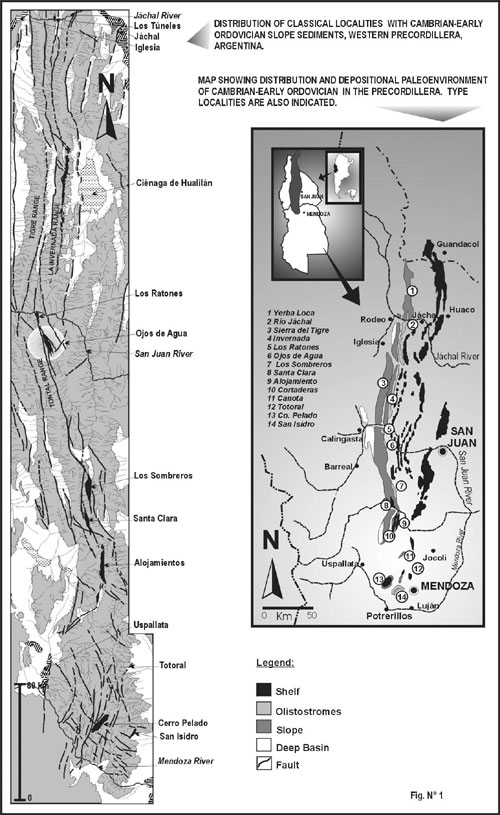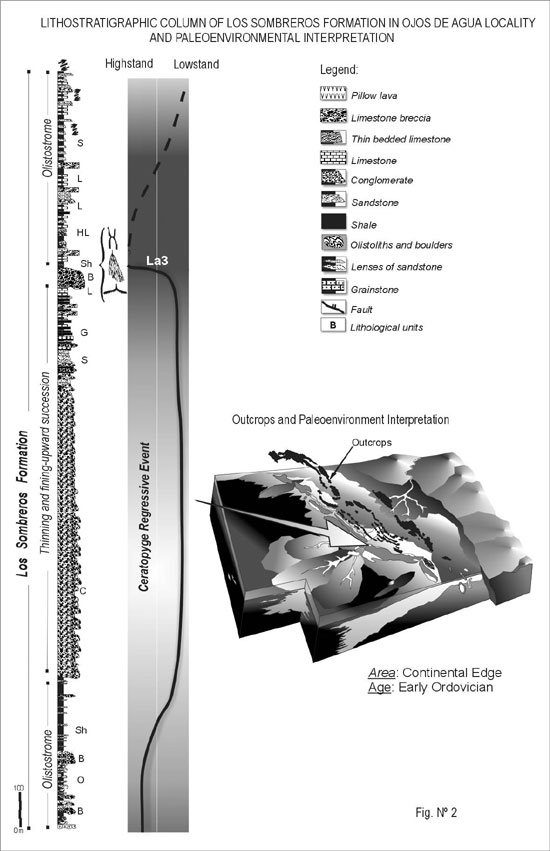
The Ceratopyge Regressive Event (cre) along the continental edge: description and paleoenvironmental interpretation of the sedimentary sequence in Ojos de Agua locality, Western Precordillera, San Juan, Argentina
Aldo Luis Banchig1 and Mariana Raviolo1
1 Departamento de Geología. Universidad Nacional de San Juan, Ignacio de la Rosa y Meglioli, s/nº, 5400, Rivadavia, San Juan, Argentina. CONICET–IANIGLA. E–mail: abanchig@lab.cricyt.edu.ar
Key words: Ceratopyge Regresive Event. Tetragraptus approximatus. Lower Arenig. Precordillera. Argentina.
Introduction
The lack of outcrops due to tectonic effects represents a main obstacle for paleoenvironmental interpretation and correlation of the Lower Paleozoic proximal (shelfal) and distal facies (edge of platform and slope) in the Precordillera. However, some successions representing continental edge or slope depositional paleoenvironments crop out in windows through the deepest thrusts of the Precordillera. This is the case at the Ojos de Agua locality that provides important evidence for the paleogeographic reconstruction of the area.
Geological setting
The Precordillera represents a thin–skinned, high–level thrust–and fold belt. The most important regional ranges include Tranca, Tigre, Tontal and Alojamientos that has a N–S strike and contain classical localities like Los Túneles, Los Ratones, Ojos de Agua, Los Sombreros, Santa Clara and Alojamientos (Figure 1). The Ojos de Agua locality is situated in the eastern flank of the Tontal range, 10 km south of the Los Ratones locality. This outcrop is limited by inverse faults at the bottom as well as the top of the succession (Figure 1).
Ojos de Agua Section
The carbonate/siliciclastic sediments that crop out at Ojos de Agua were included in the Los Sombreros Fm. by Banchig and Bordonaro (1994).
Seven lithological facies can be observed at this locality, (Figure 2): 1) Conglomerates that constitute lenticular channel fill bodies, frequently showing transitional contacts. 2) Sandstones that compose isolated tabular beds or with a transitional contact overlie conglomerates in fining–upward successions. 3) Grainstones which consist of angular quartz grains in a dark gray matrix of micritic limestones; this facies is transitional with sandstones. Isolated beds of oolite grainstones are occasionally observed. 4) Limestones breccias which constitute isolated massive beds with angular clasts of grainstones, dolomites, limestones and chert floating in a gray fine–grained matrix. 5) Shales. Green shales constitute the lower part of the succession. Graptolite–bearing black shales were observed on top of the megabreccia limestones. 6) Olistostromic hemipelagic limestones. Nodular micritic limestones interbedded with shales and silstones occur in the upper part of the succession. Boulders and olistosliths with Cambrian fossils were observed into this lithofacies. 7) Olistholits. Their boundaries are difficult to distinguish but they are identified by their different lithology and deviating fossil content. Some of them contain Middle to upper Middle Cambrian trilobites.

Figure 1
Ecostratigraphy and paleontology
The black shales that with a sharp contact overlie a conspicuous limestone megabreccia show an important change to euxinic conditions (Figure 2). These black shales contain Tetragraptus approximatus approximatus Nicholson; Tetragraptus sp. cf. T. acclinans Keble; T. decipiens Hall; Paradelograptus sp. aff. P. mosseboensis Erdtmann, Maletz and Gutierrez Marco; Didymograptus sp. and Caryocaris sp. as well as fragments of a "dictyonemid" with thin and tight mesh and irregular fenestra, resembling Rhabdinopora rather than Araneograptus, (Banchig and Moya, 2002). A similar association is present in the Tetragraptus approximatus Zone of Autralia, New Zeland and Canada.
Paleoenvironmental interpretation: The sedimentary succession begins with fine and deformed clastic sediments containing isolated lenses of coarse conglomerates, boulders and clasts (first 400 m). They are interpreted as an olisthostrome and indicate an initial process of mass flow or creep. Then follows conglomerates with lenticular geometries (3 – 4 km long and up to 800 m thick) that represent a major erosive sedimentary
Event
According to the age registered on the top of the siliciclastic succession (Upper Tremadoc – Early Arenig), it is logical to correlate these conglomerates with the Notopeltis orthometopa Regressive Event (Moya, 1997; Moya et al., 1998) or with Ceratopyge Regressive Event, which was recognized in Southern Bolivia by Erdtmann et al. (1995), Erdtmann, B.–D. and Paalits, I. (1994) and Albanesi et al. (2001) (Figure 2).

Figure 2
The thinning and fining–upward tendency, and the pinching out toward the north into an olisthostromic facies, indicate continuous decreasing of energy during the sedimentary event. An oligomictic megabreccia level suggests reworking of semiconsolidated deposits near the slope edge. The oolitic grainstone beds suggest a source from bars near the edge of the shelf and they were introduced to the depositional environment by down–slope grain flow processes.
The black shales (Figure 2, with graptholits) on the top of the megabreccia indicate a sea level rise and they represent condensation during drowning and sea level highstand.
The upper part of the Ojos de Agua succession (400 m thick, Figure 2) comprises hemipelagic limestones, shales and olistholiths with reworked Cambrian trilobites (Bordonaro and Banchig, 1990; Bordonaro and Liñán, 1994). This units probably represent a massive displacement or creep, resulting in deposits like marl flaser breccias. The intense deformation difficult to define tectonic or sinsedimentary origin The whole lithofacial variation suggests a submarine canyon incision into the shelf edge or upper slope (Banchig, 1992).
Conclusions
The black shales above the megabreccia indicate the presence of euxinic conditions associated with a major sea level rise that occured in the Late Tremadoc and Early Arenig (La3). It indicates the end of a extensive lowstand event that generated the thinning and fining–upward conglomerate deposits and may be considered to be correlatable to the Ceratopyge Regressive Event (CRE) of Erdtmann (1986).
References
Albanesi, G., Ortega, G. and Zeballo, F. 2001. Late Tremadocian Conodont–Graptolite Biostratigraphy from NW Argentine Basins. The Guide Book, Abstracts and Ordovician Silurian Correlation Chart for the Joint Field Meeting of IGCP 410 and IGCP 421 in Mongolia:121–123.
Banchig, A.L., 1992: Secuencia sedimentaria clástica–carbonática en paleoambiente de cañón submarino de la Quebrada de Los Ratones, Precordillera occidental de San Juan. IV Reunión Argentina de Sedim, II: 25–31. La Plata.
Banchig, A.L. and Bordonaro, O.L. 1994. Reinterpretación de la Formación Los Sombreros: Secuencia olistostrómica de talud, Precordillera Argentina. In Actas: 5ª Reunión Arg. de Sedimentología. V. 2: La Plata, Argentina, Asociación Sedimentológica Argentina: 283–288.
Banchig, A.L. and Moya, M.C. 2002: La Zona de Tetragraptus approximatus (Ordovícico Inferior) en la sierra del Tontal, Precordillera Occidental Argentina. VIII Congreso Argentino de Paleontología y Bioestratigrafía. L.A. Anzótegui, A.I. Lutz y O.F. Gallego (Eds.). P: 83.
Bordonaro, O.L. and Banchig, A.L. 1990. Nuevos trilobites del Cámbrico Medio en la quebrada Ojos de Agua, Sierra del Tontal, San Juan, Argentina. V Congreso Argentino de Plaoentología y Bioestratigrafía. Actas: I, p: 31–37.
Bordonaro, O.L. and Liñán, E. 1994. Some middle Cambrian Agnostids from the Precordillera Argentina. Revista Española de Paleontología, 9 (1): 105–114. España.
Erdtmann, B.–D. 1986: Early Ordovician eustatic cycles and their bearing on punctuations in early nematophorid (planktic) graptolite evolution. In: Walliser, O. (Ed.), Global Bio–Events, Lecture Notes in Earth Sciences, 8: 139–152.
Erdtmann, B.–D. and Paalits, I. 1994. The Early Ordovician "Ceratopyge Regressive Event" (CRE): Its correlation and biotic dynamics across the East European Platform. Geologija, 17: 36–57, Vilnius
Erdtmann, B.D.; Kley, J.; Müller, J. and Jacobshagen ,V. 1995. Ordovician basin dynamics and new graptolite data from the Tarija región, Eastern Cordillera. South Bolivia. 1The Pacific Section Society for Sedimentary Geology, Fullerton, Book 77, 69–73.
Moya, M.C. 1997. The Upper Tremadoc and the Upper Arenig: two critical times in the evolution of the Ordovician basin in the north of Argentina. 18th Regional European Meting of Sedimentology (Heidelberg), GAEA, 3: 243–244.
Moya, M.C.; Monteros, J.A. and Monaldi, C.R. 1998. Graptolite dating of a Lower Ordovician unconformity in the Argentinian Andes. Proceedings 6th International Graptolite Conference (GWG–IPA) and 1998 Field Meeting, IUGS Subcommission on Silurian Stratigraphy (J.C. Gutiérrez–Marco and L. Rábano, Eds.). Temas Geológico–Mineros ITGE, 23: 227-230.
Received: February 15, 2003
Accepted: June 15, 2003